TV revenue distribution – comparing Italian and English models
Last week Diego Tarì (twitter @Tifbilanciato) had a significant scoop on his site www.tifosobilanciato.it when he published a club-by-club breakdown of Italian TV revenue for Serie A in the 2012/13 season. The story was quickly picked up by various sites including Italian sport newspaper Tuttosport. The Tuttosport article (in Italian) is attached here:
 | 2012 10 26 Tuttosport article.pdf Size : 451.915 Kb Type : pdf |
This information is particularly interesting as the breakdown of TV revenue is never usually published in Italy (unlike the PL, where the information is freely available).
I have converted the Serie A breakdown from euros to pounds and all figures are in millions:
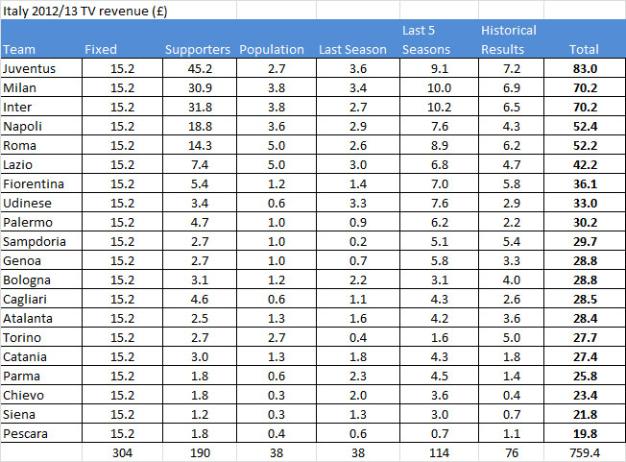
The first thing to note is that, unlike the Premier League which determines the final split at the end of the season, the Italian totals are determined before the season starts based on historic information.
There are five elements that contribute to the overall deal. The split is as follows:

Fixed Amount Element
Like in England, each club receives a an equal basic revenue element. In Italy each club receives £15.2m.
Supporters Index Element
This is the largest pot (25%) and is the most contentious part of the distribution. Its calculation is far from transparent and has been described as ‘one of the best kept secrets in Italian democracy’. It is compiled by three different research companies - Italians are polled to determine whether they are a football enthusiast and, if so, which is their favourite team. It doesn’t take into account average crowd size and is purely based on respondents preferred teams. The research calculated that there are 37.6m ‘football fans’ in Italy (out of a population of 60.6m).
The Supporters Element creates a significant disparity in income – Juventus have considerable national support and receive £45m from this pot (compared to just £1.2m from unfashionable Siena).
Town Population
This element allocates revenue based on Province size, rather than the actual population of the town/city. As we would expect the two teams in Turin (Torino and Juventus), receive the same revenue from this pot. The big winners are Roma (£5m) whilst Siena and Chievo receive just £300k - there is nothing clubs can do to increase the size of their payment from this pot.
Last season performance
As in the Premier League, there is a pot that allocates revenue based on a club’s League position. However in Italy it only accounts for 5% of the revenue and any team that punches above its weight and achieves a high position, receives rather scant reward. The difference between winning the Scudetto and finishing bottom is only £3.4m.
Last 5 seasons
15% of TV revenue is allocated based on League position attained over the previous 5 seasons. The established large teams again receive the largest share of this pot. Udinese receive some reward for their recent good performances, having qualified for the Champions League for the last two seasons.
Historical Results Element
10% of the revenue is determined by league placings since 1946. Again, Juventus and the Milan clubs receive the biggest pay-outs. Interestingly, Torino, who had a strong 70’s/80’s and were the dominant force in Italian football in the1940s also did well in this category.
Clearly, the Italian distribution method heavily favours the status-quo. Juventus, for example, receive over 4-times the revenue of lowly Pescara. The traditionally large clubs are continually rewarded for having a large number of ‘supporters’; coming from large provinces, and for their past performance. It would be virtually impossible for a club to break into top tier of clubs on a long-term basis. League position on its own has little bearing on the amount a club receives. Teams can occasionally have a good season or two but cannot compete long-term. Chievo finished 5th in 2002 and 7th in 2003 – a quite remarkable performance that couldn’t possibly be maintained over a prolonged period.
It is interesting to compare the overall Italian TV rights club pay-outs to those in the Premier League:
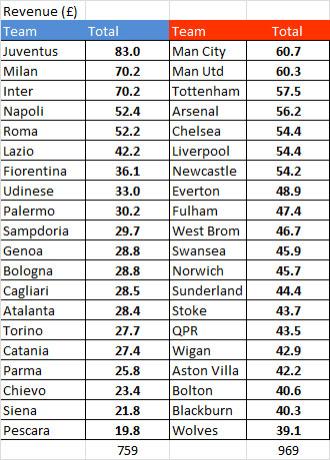
Despite the Italian pot being 22% lower than the Premier League TV revenue, top earners Juventus receive £22m more than Man City. AC Milan received £10m more than the Manchester clubs. Clubs in in 3rd to 6th place all receive around the same across the two leagues. Where the real disparity lies is from teams from 7th place down. Wolves receive double the TV income to the bottom-paid team in Italy and half the Italian teams receive around £17m a season less than their English counter-parts.
The Premier League appears to be a model of equality compared to the Italian system. In England, the difference between top and bottom is only £21m, with City earning just 1.5 times Wolves’ earnings (compared to Italy, where Juve receive £63m more than Pescara (4.2 times their revenue).
The English TV breakdown is fundamentally quite different to the Italian model.
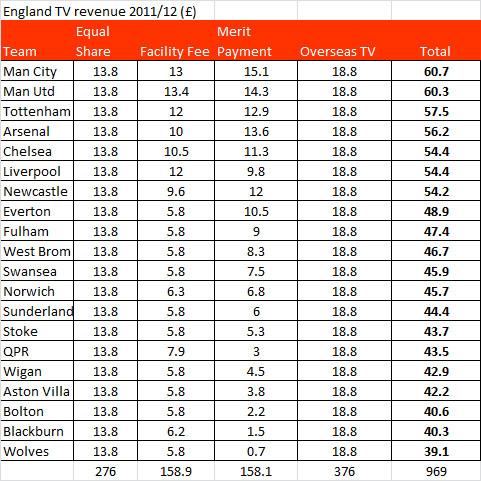
Equal Share & Overseas TV
The Premier League gives each club an ‘Equal Share’ payment and also equal distribution of Overseas TV income. Each club received £32.6m irrespective of league position or how many times they appeared on TV.
Facility Fee
The Facility Fee is determined by how many times a club appears on Live Sky games. The difference between top and bottom is fairly small with on £7.5m separating Man Utd and the 10 clubs who received the lowest payment.
Merit Payment
The Merit Payment is determined by final league position, with each place worth around £1.2m. The top team receives 14.4m more than the bottom team. In Italy this pot is significantly smaller and the difference between top and bottom is only £3m. Swansea were over-achievers in the Premier League last season and received £7.5m for their 11th place finish (compared to £1.8m in Italy paid to a team with a similar finish).
With some justification, the Premier League prides itself in the fairness of itsTV distribution. Compared to Italy, the Premier League appears to be a rather egalitarian Utopia.
What if the Premier League adopted Italy’s model?
It is interesting to speculate on how the TV model would look in England if the Serie A model were in place here. Applying the Italian model to the Premier League isn’t entirely straight forward. We don’t have the all-important ‘Supporters Index’ so have to make do with an educated approximation. The remaining information required to construct the payment table (such as population size and historic results since the war) are all freely available.
Assuming the size of the TV revenue pot is not changed, the Italian model makes the Premier League TV distribution look like this:
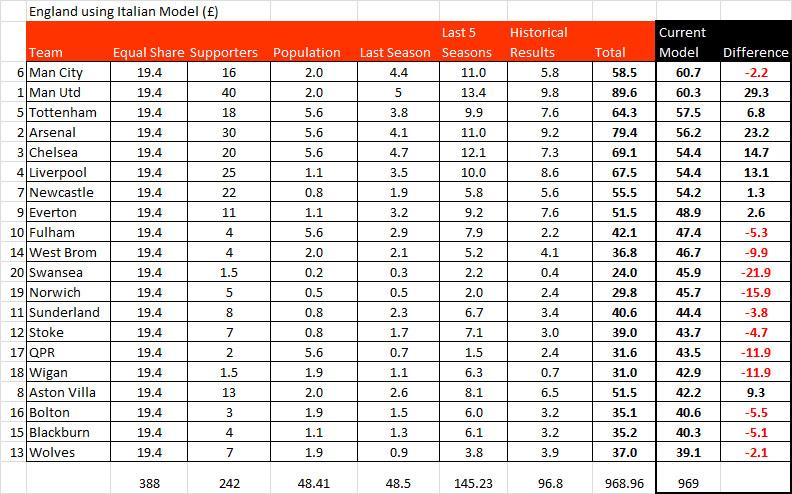
Five of the top six teams would gain significantly under the Italian system. The only exception is Man City who probably have the lowest national fan base to the current top teams. Arsenal and Man Utd would be set to gain the most due to their large national fan base. Arsenal also have the benefit of coming from a large city and have very good Historical Results.
At the other end of the payment table, other than Aston Villa, all clubs below 8th receive less under the Italian Model. Villa would gain as they would score highly in the Supporter index; are from a large city, and score well in post-war results. The big losers would be Swansea – they would be nearly £22m worse off and end up being the poorest rewarded team, despite their good league position last season.
There are some other anomalies caused by the calculation of the Population pot.. The London clubs all do well in this pot and, for example QPR receive over £4m more than Newcastle and Liverpool by virtue of coming from a larger city.
To English eyes, only a fairly myopic Arsenal or Man Utd fan would argue that the Italian model has anything to recommend it. Clubs struggle to compete at the top-level as it is and over time the Italian model would probably result in an entrenched elite of five or six clubs. Long-term, it would also be very difficult to knock Arsenal or Man Utd of the top of the table long-term.
What if Italy adopted the Premier League’s model?
It is also interesting to consider what would happen in Serie A if Italy adopted the Premier League’s seemingly fairer model.
Other than one element it is a fairly straight-forward process to apply the English model to Serie A.
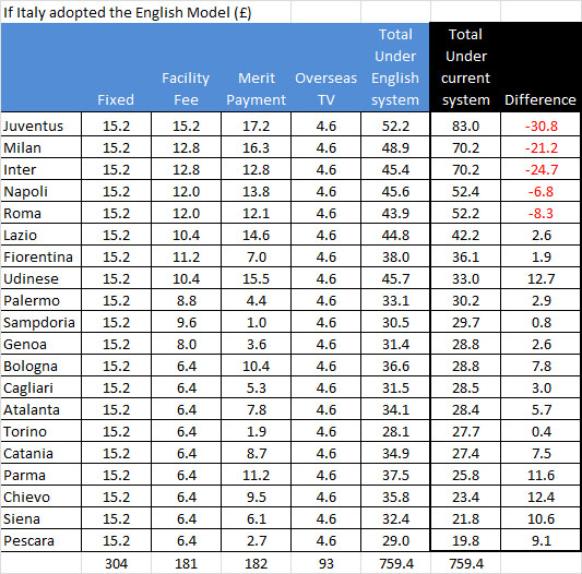
The immediate impact would be at the top end, with Juventus an eye-watering £31m worse-off. Milan and Inter would also be significant losers. However, only 6 teams would be worse off and Parma, Chievo and Udinese would rightly rewarded for their high league table placing last season.
Under this system, the lowest payment would be £29m, compared to just £19.8m under the current system (representing a welcome 46% increase in TV revenue for Pescara). As we would expect, the gap between the top and bottom earnings shrink dramatically.
The one problem area when overlaying the Premier League model onto Serie A relates to the Facility Payment element. This pot is determined by the number of times a team is shown on a Live TV game. The purpose is three-fold:
- To reward the larger clubs (who are more-often selected for a Live game)
- To reward teams who are doing well in the League (as their games are also more-often selected)
- To ensure all teams get some payment from this pot ( as all Teams must be shown a required number of times)
In Italy, all games are shown Live, so this pot is not directly comparable. If Serie A were to adopt the PL distribution model principles it would need to find a similar, proxy measure (potentially based a weighted mix of club club attendances, supporters and the league position), whilst ensuring there are no teams who receive excessively high or low allocations from this pot. For the purposes of the above model, I have allocated the Facility Fee payments in a manner that is consistent with the current Premier League Facility fee levels and process.
As an aside, it is interesting to note the impact of the Overseas TV deals. These are paid to clubs as a separate pot in the Premier League and are worth a huge £376m to English clubs, compared to the £92.8m (E116m) secured by Serie A.
Although the Supporter Element seems unfairly skewed to the big clubs, it is not likely to change any time soon. In June 2011, the method for calculating the Supporters Element caused some heated debate with the large clubs successfully forcing through a change in the way the payments are calculated.
Payment had previously been more heavily weighted towards attendance figures but the Italian giants were able force the smaller clubs into increasing the weighting of the survey question that simply asked football enthusiasts to 'name their favourite team'. The discussions got rather fierce and there were allegations that the smaller-to-medium clubs only accepted the change after the large clubs threatened to blacklist non-compliant clubs and to stop buying any players from them in future. Transfer fees represent a significant source of income for many of the smaller clubs and any ‘blacklist’ would have had a huge impact on the affected clubs. The change to the Supporters Index was made in November 2011 and since then Napoli (one of the ‘squeezed’ middle-ranking clubs) has twice unsuccessfully attempted to have the Supporters Element change overturned to it could gain a higher share of the payments.
It is also interesting to consider the concept of the Benefactor Ownership model in relation to the two leagues. In Italy, the payment for achieving a high league position is only 5% of the total pot, so it would require an owner to have very deep pockets if they wished to fund a small or middle-size club so they could reap the full financial rewards for their club’s success. In Italy rewards are not as instant, with payments being based on elements that would take serious time to change (such as national ‘supporters’, 5 year results and post-war table positions). However, in the Premier League a club is rewarded almost instantly via the Merit Payment and the Facility Fee for success on the field.
Interestingly, the fairness of the TV fund distribution actually makes the Premier League a much more attractive proposition for a potential wealthy owner. If we had a less egalitarian distribution of TV funds, we would probably have had fewer wealthy individuals choosing to inject their money into clubs such as Fulham, QPR, Stoke and Bolton.
This article has been produced in conjunction with @Tifbilanciato and an Italian-tailored version appears at www.tifosobilanciato.it
blog comments powered by Disqus
